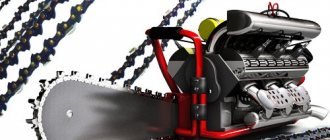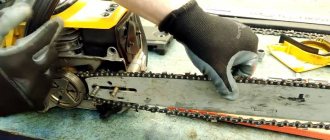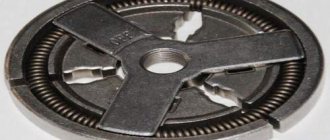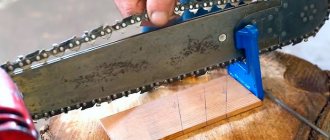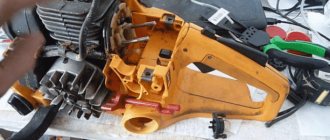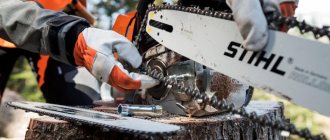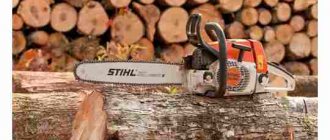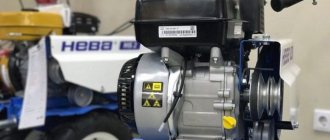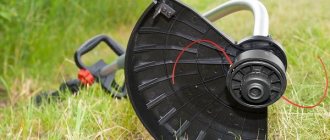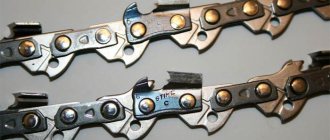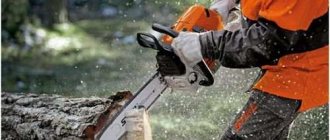If you bend a tire
I read a debriefing on one forum in which they discussed the issue of the functionality of a bent tire on a chainsaw. Let's also consider the case if you bent a tire while sawing with a chainsaw.
I remember the end of the 90s, when we worked on through-cuttings. The forest was dense, the feller was a young, strong guy (now he is one of the best active fellers in our area). We were cutting down spruce using a Ural chainsaw, and the feller managed to bend a tire on the chainsaw 3 times in one day! But like a good blacksmith, he beat a strong Ural tire, with a shock-absorbing tip, on a large stump and brought it into working condition. The forest continued to fall until the end of the working day. The main reason for such embarrassment for the feller is “doping”, in the form of an intoxicating drink.
Did I bend the tire? Of course! There have been at least three cases in my practice where I bent a tire. This happened when felling large aspen and birch trees. The trees were inclined, and one of them could not be pushed out due to the wind, and as a result, the sawn “lobe” of the tree came toward me. The tool was never damaged - I managed to turn it out, but the tire bent! In all cases, the bends of the tire were insignificant, there was no damage to the blade, so it was possible to fix the headset using a makeshift “forge” method. The reasons for my negligence are inattention and fatigue.
So is it possible to fix the tire and is it even worth doing?
In fact, the manufacturers provide for straightening a bent tire, as approved by service repairmen. The question is the degree and type of damage to the cutting set. In repair shops, the bent blade is unbent using a press, and local clamps in the groove are also released using the appropriate mandrel method. In the case of clamping and deformation in the tip area, the situation cannot be corrected, and if something can be done in this case, it will not be for long. It is not recommended to straighten the tire with hammer blows, as in our case, since there is a high probability that the welding point of the sheets will diverge.
So, a bent tire can be corrected using the method suggested by experts. Even if the deflection angle is significant, there is no obvious damage to the canvas. But what to do in “emergency” situations in the forest and is it worth doing?
Without a doubt, a feller should have a spare tire! No questions asked here. But carrying this supply with you is impractical and everyone leaves the tire in the booth. If the feller uses a wedge and has a sledgehammer or axe, he can try to fix the tire on a stump. In one of my cases, the tire was bent evenly, or rather bent, and I fixed it without the help of blows. I simply placed it on two support points and bent it with my hands under my own weight. In this case, of course, you should not overdo it. Closer to the driven sprocket towards the tip there was a curved area, but I corrected that too by inserting it into a deep thin crack in the wood. The steel of the tire does not have any special “springiness,” but again you need to be careful and not overdo it. In other cases I had to use an axe.
Those who work in state-owned enterprises are not particularly concerned with such problems and throw away damaged headsets, citing defects. Although there is a special production standard and the “responsible people” for consumables require a report, in most cases they are “unspoken” and no penalties should be imposed on the employee. Thus, some enterprising fellers acquire an “extra” tire from the treasury and dump it “on the side” or at home for personal use.
To prevent a similar incident involving tire damage from occurring, I would only like to wish:
Tell us your situations and thoughts. What do you do if you bend a tire ?
Source
Why the chain falls off, find out the reasons
If you are wondering why the chain on your chainsaw falls off, it means that there is some problem with the mechanism. There are three main reasons
this problem: improper functioning of the tire, stretching of the chain and poorly secured driven sprocket. Let's take a closer look at each of the possible causes of failure.
Bus problems
When problems arise with a tire, the chain tension almost always weakens.
. This problem usually occurs at the tire mounting location.
This place is located in the groove between the outer plate, which is located on the chain set casing, and the inner plate located on the motor housing. The casing together with the tire is secured with a bolt. This mount is called an “engine assembly”. The drive sprocket and tire mount are protected by special covers.
If the retaining bolts become loose, the tire will begin to move or vibrate. If the tire is in good condition, then the chain tension should be normal. After the braces, she will walk for at least five working days without braces. Therefore, you need to properly tighten the bolts that hold the tire.
To understand how to tension a chain on a chainsaw, you first need to
locate and lower the chain brake. The tension screw is located next to the bar; it is turned until the chain is tight on the bar. Then pull the chain in a clockwise direction. If it does not move, then it needs to be loosened a little by turning the tension screw in the opposite direction.
The chain has stretched
If you have a sagging chain on your chainsaw, then this indicates a malfunction of some mechanism; one of the options is wear of the chain itself.
Over time, the metal deforms and the chain becomes 0.5-1 cm longer. The best way to fix this problem is to buy a new chain, but there is a way to get the old one back into operation. Experts say that this is very difficult and almost impossible, but we will tell you how this can be done at home.
For this we need
:
- vice;
- needle file;
- electric welding machine (not needed in all cases);
- hammer;
- pliers;
- goatee
A regular chainsaw chain is made of strong steel, making it difficult to come apart. The chain must be disconnected on the inside of the rivet, which serves as the connecting mechanism.
To start, you need to fix the chains in a vice, and then gradually grind off the protruding part. You need to grind it with a file or needle file. It is not recommended to use a grinder, as there is a risk of damaging the side parts of the links. After grinding, the rivets are knocked out using a bit. A broken rivet should not be thrown away. You may not be able to find a replacement for her. Manufacturers of gasoline saws do not produce separate parts for the chain, since they do not assume that consumers will be able to repair the chain themselves. Most likely, you will not be able to make a new rivet yourself, so you will have to install the old one.
In order to shorten the chain, you need to divide it in two places. But remember
that the number of guide lugs on the inside of the chain and the distance between them must be combined with the drive sprocket.
Important!
When welding a link, set the current to the minimum value.
Select an electrode with the smallest diameter, so you will not touch adjacent links. After removing one or more links (depending on the degree of chain stretch), the chains can be joined. We connect them with old rivets, while pressing them tightly on the sides.
Next we need a welding machine. The rivet must be welded to the side parts of the link. After this, use a file to grind off the excess that was formed during welding. The chain can be considered serviceable again.
The drive sprocket is poorly secured
One of the possible causes of a sagging chain on your device is a problem with the drive sprocket.
. Most often, everything happens due to the fact that the star is poorly secured. Now we will tell you how to properly fasten the star and then put the chain on the chainsaw.
First you need to remove the engine protective cover. Next, remove the spark plug protective cover and pull out the air filter. Then you need to unscrew the spark plug with a special key. A special stopper is placed in its place, which fixes the piston in a certain position. Using a special wrench (you can use a universal wrench for an angle grinder), we turn the clutch disc clockwise until the piston reaches its highest position. If you look into the spark plug hole, the piston should remain at the bottom. You can use a thick rope as a stopper; it is better to fold it several times. After fixing, you can clamp the drive sprocket by turning the clutch disc counterclockwise.
Did you know?
The Druzhba chainsaw got its name in honor of the tercentenary of the unification of Ukraine with Russia in 1954.
After clamping, you need to do everything in the reverse order, that is, assemble the chainsaw. A chain is put on the tire; it must land on the drive sprocket, which holds it. The tire is placed in special mounting holes and bolted. Then protection is put in place.
Practical tips for repairing a chainsaw tire yourself
A chainsaw is a very useful thing on the farm. After all, it quickly and relatively easily solves a lot of problems in home construction, gardening and landscaping. Chainsaws are a rather capricious tool, but when handled correctly they are an indispensable assistant. Which has one weak point: the guide rail. It bears most of the operational loads. This means that knowledge of why tires fail more often than other parts of chainsaws and how to properly replace them if necessary will again and again help you save money and time during seasonal or project work with the tool.
Malfunctions and how to repair a tire
To repair a chainsaw with your own hands, you will need a detailed diagram and an understanding of the operation of the basic mechanisms of the device. The guide bar and its fasteners are vulnerable, consumable parts that experience the greatest load. You can repair the chainsaw tire yourself or by contacting a service center. Wear and breakage in this area are indicated by the lack of normal tension, sharp or intermittent movement of the chain, the inability to provide normal lubrication and fastening of the cutting axis in relation to the body of the unit. Types of breakdowns:
How to sharpen
A special machine is the most effective method. But using a file you can also achieve good results.
Chainsaw bar mount
The tire and its fastening elements belong to consumable parts. Wear of this unit occurs both under work loads and as a result of improper operating conditions. You can immediately identify any faults in this area. The tire will not be able to provide normal tension, lubrication and smooth running of the chain, and its fastening will not be able to secure the cutting axis relative to the tool body.
Fastening the saw bar
It is unsafe to operate a saw with a faulty guide bar. Therefore, at the first sign of a unit failure, you need to turn off the engine and find out what’s wrong. Knowledge of the design features of the tire and its mounting on your chainsaw will help you successfully eliminate the cause of the malfunction.
Malfunctions and how to repair a tire
To repair a chainsaw with your own hands, you will need a detailed diagram and an understanding of the operation of the basic mechanisms of the device. The guide bar and its fasteners are vulnerable, consumable parts that experience the greatest load. You can repair the chainsaw tire yourself or by contacting a service center. Wear and breakage in this area are indicated by the lack of normal tension, sharp or intermittent movement of the chain, the inability to provide normal lubrication and fastening of the cutting axis in relation to the body of the unit. Types of breakdowns:
How to sharpen
A special machine is the most effective method. But using a file you can also achieve good results.
Weak points of the saw bar
The main parts of the tire are the body and the groove. The width of the latter is called the gap. The front part of the saw bars is made of high-strength steel. The tire body is also hardened.
Saw bar device
Currently, there are various types of saw bars on sale, which differ in:
Different types of saw bars
The shape of the shank and the location of the technological holes in the tires for most amateur and professional chainsaws are standard, but structurally they can be divided into open and closed. Obviously, the former are inferior in terms of reliability of attachment to the body of the latter, i.e. The tire casing and bolted connection bear increased loads. You also need to monitor the integrity of the sprocket teeth - if they become dull or chipped, they will quickly render the leading links of the chain unusable.
Parameters and options for chainsaw tires and their elements in the photo
The chainsaw tire requires regular maintenance. After each operating session, its grooves must be cleaned of dirt and sawdust, otherwise lubricant will not flow to the chain. The wear of the tire groove should be uniform, so it should be turned over from time to time. In addition, before starting work, you should always check the presence of oil on the chain body and in the gap.
Checking the operation of the lubrication system
It is not recommended to use more than three chain sets with one bus. During operation, the gap, despite all the strength of the metal of the tire body, expands, which leads to the appearance of play when the chain moves and its sagging even with the extreme forward position of the tire.
The driven sprocket, located at the front of the tire, is lubricated separately. Oil does not get there, unlike the rest of the guide groove. It is poured into special holes in the front of the tire, and if there is no sprocket, it is applied to the toe of the tire.
Separate nose sprocket lubrication system
Why does it wear out
This is one of the questions that chainsaw owners constantly ask. The answer is simple. Friction occurs on the surface of the headset, causing wear and tear.
Another pressing question: Why does a tire wear out prematurely? You can answer this by studying the design of the tire and how the lubrication system works, which we will try to do.
The lubrication system starts with the oil tank, where oil is filled, and then, using an oil pump, is transferred to the place where the bar shank contacts the chainsaw body. The tool pump is equipped with a special screw for adjusting the oil supply. There is a special groove at the tire mounting point that corresponds to the lubrication hole on the tire. The cause of premature wear may be insufficient lubrication of friction parts, which, in turn, occurs with subsequent malfunctions.
- Excessive contamination of the oil filter (the first thing you need to pay attention to);
- Contamination of the oil supply channels on the headset or on the instrument itself;
- Incorrect regulation of oil supply by the pump;
- Malfunction of the pump itself;
- Use low-quality lubricants or oils that do not meet the requirements of the chainsaw manufacturer.
READ How to Clean a Shtil Chainsaw 180 Video
To increase service life, manufacturers recommend using special oils with high adhesion.
Thanks to this property, at high chain speeds, the oil is distributed and retained throughout the bar, and not just at the top, as is the case with conventional oils.
Replacing the chainsaw bar and its fastening elements
To replace fastening elements, tires and chain fittings, it is necessary to disassemble the entire fastening mechanism. It doesn’t hurt to prepare in advance a rectangular piece of fabric or cardboard, as well as free space on the table for disassembling the tool and temporarily placing the removed parts.
Chainsaw bar mounting diagram
Replacing fastening elements and the chainsaw tire is necessary when:
That is why the saw bar and fastening elements are consumable parts - to replace them you only need one universal wrench, supplied with the tool. And, of course, knowledge of the algorithm for disassembling, assembling and adjusting the mechanism.
Chainsaw with tire removed
To disassemble the tire mount:
The sequence of actions when removing a chainsaw bar in the photo
After this, the chain must be put on a new bar and the latter must be installed in the groove to be installed. Next, the headset is engaged with the drive sprocket and closed with a lid. Immediately before starting work, do not forget to check the chain for slack and the quality of its tension.
The chainsaw is back in action
If the new bar is attached and the headset is installed correctly, the chainsaw is ready for use again. By the way, just in case, you should make sure of this by sawing several thin branches.
Design features of drive sprockets
The pitch of the drive gear teeth is one of the main parameters of the unit. It must coincide with the pitch of the chain links and, no less important, with the pitch of the teeth of the driven sprocket located at the end of the chainsaw bar.
Drive gears, according to their design, are divided into:
Experts identify the following signs of wear on the drive gear teeth:
A chainsaw sprocket with such signs should not be used; it must be removed and replaced.
According to the manufacturer's recommendations, the tool should be inspected before starting work. In this case, be sure to check the condition of the saw bar and whether it is securely fastened. If the screw that regulates the position of the chain roller and its tension is loosened, or the nuts securing the bar to the body are loosened, it deviates from the plane of the chain. In this case, the blade rollers rest not on the middle, but on the edges of the teeth, increasing the load on them and on the chainsaw as a whole. Increased wear leads to premature failure.
READ Electric saw Interskol Pts 16 2000t Scheme Video
Sprockets with replaceable and stationary crown
After tightening the fasteners and making adjustments, do a test run. If free play remains, the sprocket will have to be removed and replaced.
Reasons why a chainsaw moves to the side
The reasons for the chainsaw pulling to the side may be:
Wear of saw chain teeth and chainsaw bar
Uneven wear of the teeth of the saw chain is the main reason why the chainsaw wanders while sawing. Most often this occurs when a tooth gets caught on a nail or something similar. Naturally, this leads to a decrease in sawing efficiency. As a result, the master begins to put more pressure on the saw, thereby increasing the load on the bar and chain.
With this type of sawing, sharp teeth cut the tree normally, and dull teeth simply roll over the cut site like a car wheel going over a bump. However, the car has a suspension system, shock absorbers. Therefore, such “forcing” of an obstacle has almost no effect on the car.
The saw does not have such systems. Therefore, the chain, bending under such influences, simply presses on the ribs of the tire, gradually moving them apart. In addition, this is accompanied by increased wear of the chain shanks. If timely measures are not taken, wear will develop exponentially.
Incorrect saw chain tension
An equally important reason why a chainsaw is pulled to the side is incorrect or untimely tension of the chain - a rather complex and capricious element. According to the standard instructions, the chain must be tensioned in such a way that when you try to lift it, three shanks are visible.
What to do if the chainsaw pulls to the side when sawing
Knowledge of the theoretical points outlined above allows us to determine ways to prevent and eliminate this phenomenon:
How to straighten a deformed tire
If there is no time for editing, then the tire can simply be turned over to the other side. If you have already turned it over, then it is no longer possible to avoid editing. To perform editing you need to arm yourself with:
First, the tire is removed and the complexity of the problem is checked. To do this, the tire is placed on a level table, and a square is attached to it. This allows you to determine the degree of deformation that has occurred.
Then the grinder is clamped in a vice, and the table for laying the tire is raised to the level of the disk.
Using a square, the exact angle of the grinder disk is set, and the tool is finally clamped.
Having turned on the grinder, the tire is treated with the grinder several times on both sides.
Then the quality of the work performed is assessed visually.
The quality of the adjustment is also determined by a square according to the previously described method.
It is quite clear that after the adjustments were made, the sides of the tire were slightly shortened and the groove on it became less deep. Therefore, it is necessary to make sure that the shanks do not extend beyond the groove. If the groove is not deep enough, the tire will have to be replaced.
So, now you know what to do if the chainsaw drifts to the side while sawing. I hope this information will allow you to easily cope with this defect.
Source
How to Level a Chainsaw Bar
How to shorten a chainsaw chain without the help of others?
Virtually every owner of a suburban home has a chainsaw. And we don’t even have to talk about the inhabitants of rural areas: such a tool is an urgent necessity for them. And the chainsaw asks for careful handling and timely maintenance. All service rules are correctly stated in the annotation.
Equipment and rules of use
The saw kit should include several chains (minimum 3) plus 2 bars. After 3 hours of operation, it is recommended to rotate the tire. After another 3 hours, the chain is replaced. Such ordinary rules can significantly extend the service life of all parts of the chainsaw. But in life, we actually do not adhere to advice and are guided by our own ideas about what is necessary.
Comparison chart of chainsaw features.
After a certain time of operation of the chainsaw, we simply tighten the chain. And at a certain moment we notice that the tension system no longer allows us to tighten the chain. The chain has stretched to its maximum. You cannot work with it further, because the stretched chain will begin to break the driven sprocket, as a result of which tire wear will greatly increase. The chain needs to be shortened.
Another reason why you have to shorten the chain is to “fit” a longer chain from another chainsaw to fit your bar. This also happens quite often, because there is an opinion among users that higher quality chains are made for “professional” chainsaws.
Required Tools
Chainsaw manufacturers say that it is unrealistic to shorten the chain at home, because the development of their production itself is very complex and requires high-precision equipment. Practice indicates that nothing is impossible. In order to shorten the chain, you will need:
How to remove rivets?
The main characteristics of a chainsaw chain.
The chainsaw chain is difficult to disconnect. The rivets are made of high quality steel and have a geometric shape that does not allow the rivets to simply be knocked out of the link. The inside of the rivet has a larger radius. At this thickening, the link rotates, and the outer parts of the rivets serve only a connecting function, so they are quite easy to firmly fix on the outside of the chain. Removing the rivet is done in the following way: the chain is fixed in a vice, and the protruding part is ground off. When stitching, we try not to destroy the side parts of the links.
It is not recommended to use a grinder, as the parts will heat up very quickly, which will lead to a change in the physical parameters of the metal. It is better to use a ratfile or needle file for grinding. Stitching is done on both sides of the link. Now the rivets can be knocked out of the chain using a bit, slightly bending the side parts of the links.
The circuit came out to be disconnected. Do not rush to throw away the rivet removed from the chain. It may be that you cannot find a suitable replacement for it. Chainsaw manufacturers do not imply that the chain will be repaired independently, therefore they do not release such rivets on the product market.
Diagram of a chainsaw tooth structure.
It is also more profitable for trading organizations to sell chains in their finished form than small parts for repair. For these reasons, it will be very difficult to find a suitable rivet with a suitable geometry. Making it at home will be even more difficult, so you will have to use an old rivet.
As you may have guessed, the chainsaw chain will have to be disconnected twice. Do not forget to calculate in all this so that the number of guide protrusions on the inside of the chain and the distance between these protrusions are combined with the chainsaw drive sprocket. If you are shortening an unusual chain, this is not necessary. And if this is a chain from another model of chainsaw, then everything needs to be measured and calculated very carefully. A deviation in the chain pitch (even a small one) from the characteristics given by the design will lead to the fact that the chain will stretch again in the shortest possible time (in the best case) or break the chainsaw sprocket. The end of the tire will come, as the driven sprocket will rapidly overheat.
Tips for use
It is not enough to know how to tension a chainsaw chain. You need to properly care for your saw, then you will extend the life of not only the chain, but also the entire mechanism. Here are some operating tips :
- Clean the air filter regularly and lubricate it with oil. If necessary, replace the filter with a new one.
- Before starting work, always check that all nuts and bolts are tightened so that the mechanism does not malfunction during operation.
- Regularly lubricate the bearings and do not forget to clean the spark plug from smoke.
- Lubricate the driven sprocket. And after working with a chainsaw, do not forget to clean it.
- Always lubricate, sharpen and tighten the chain on time, then there will be no problems with the bar and chain.
READ How to saw the corners of a ceiling plinth with a miter box
If you use all the tips above, your device will last much longer than the warranty period
Source
Household, semi-professional and professional hand chainsaws, regardless of cost and performance, have the same design. The cutting kit, which includes a chainsaw bar and a dust chain, is classified as replacement equipment.
The decision about which tire to put on a chainsaw is made by the owner, taking into account many factors. First of all, this is the compatibility of the seat and oil supply channels with the working area, engine power and features of the work to be done.
Specific assistance in choosing tires independently can be provided by recommendations from experienced specialists or information on the instructions for use.
In particular, a long set of pollen is best for cutting and sawing large diameter trees, while a short set is best for rooting trees and preparing for timber installation.
